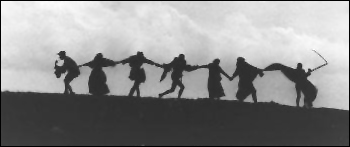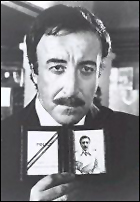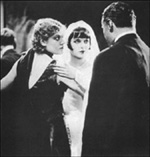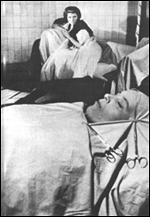
Movies
I
She liked certain farces that I couldn’t bear to watch, the feeble later Pink Panther movies among them. Peter Sellers was her favorite comedian by a long way, and Blake Edwards her favourite director of comedies. Edwards’ The Party, with Sellers doing his Asian-Indian act, was, I’m sure, the high point of comedy for her.
She didn’t particularly care for the classic comedians—Chaplin, Keaton, the Marx Brothers. She didn’t voice any particular dislike for them, but she never asked me to rent any videos by them. I think she felt that they were Classics, and that one was meant to be respectful towards them and comment approvingly on them, or discriminate among them. She liked W.C. Fields best, I’m pretty sure, especially in The Barber Shop, but also in movies like The Bank Dick and It’s a Gift, in which, at least at the outset, he’s continually victimized and endures it patiently, but with small private gestures of protest and revolt.
She liked almost all the James Bond pictures, and almost all the James Bonds, though Connery was of course at the top. She liked Clint Eastwood, this side of idolatry. I don’t think she felt particularly drawn to classic hero-actors like Tracy, Bogart, Gable, Cooper, Stewart. She preferred Gene Kelly to Fred Astaire. She loved Gregory Peck, probably partly for his gentlemanliness, and said that at one point he had been her movie idol. She liked various “serious” actors and actresses who were—well, not all that much my own cup of tea. Robert Redford, Meryl Streep, Dustin Hoffman, Paul Newman, Joanne Woodward.
Among her dislikings: hunks like Stallone and Schwarzenegger, the latter of whom she viscerally detested; Jane Fonda (this went back to the Vietnam years, and to her general spoilt-girl bossiness and preachiness); Jill Clayburgh—again modishly skinny-bony; Sigorney Weaver’s butch heroines in Aliens and Aliens II (she shrewdly noted the anti-gestation, anti-motherhood aspects of the latter).
II
For a few happy years we had gone to horror movies together, especially the Hammer ones. Then she dropped out, partly for physical reasons. When we were living on Queen Street (with the bedbugs) we didn’t have a car, and I would frequently walk a number of blocks to the two Gottingen Street movie theatres, the Casino and the Vogue. She preferred to stay home and paint.
When she returned to horror movies in the Seventies, or perhaps it was the early Eighties, she was exasperated by the special effects in The Howling, and this became a kind of paradigm of awfulness for her, and she simply refused to listen, at least concessively, when I tried to defend some of the movies that I was seeing. She said she had liked the Hammer movies, and others from that period, because their horror was essentially psychological. She despised would-be-flesh-creeping or nauseating gore effects. I’m sure she could imagine more horrible horrors herself. Georges Franju was similarly caustic about some Japanese harakiri movie in which one saw a pile of guts spill out.
III
Her favourite serious movies were Renoir’s La Grande Illusion, Pabst’s Lulu, Browning’s Freaks, Bergman’s Shame, Resnais’ Night and Fog, Losey’s Eve, Reed’s The Third Man (she must have seen it at least half a dozen time, I a dozen), Lynch’s Eraserhead, Brooks’ King Lear, Buñuel’s The Exterminating Angel, Powell’s Peeping Tom. She liked all the numerous movies by Bergman that she saw. He was probably the movie-maker who spoke the most intimately to her. She liked everything that we saw by Buñuel, and everything by David Lynch She liked Orson Welles’ Othello a lot, also Losey’s The Servant, also Georges Franju’s Le Sang des Bètes (The Blood of the Beasts). She liked Herzog’s Even Dwarves Started Small and Aguirre, Wrath of the Gods, and Peter Weir’s Picnic at Hanging Rock and The Cars that Ate Paris. She liked virtually every Australian movie that we saw together.
IV
A few words of hers changed the way I looked at movies. When we were in London in the summer of 1962, the National Film Theatre on the South Bank had a showing of Franju’s Les Yeux sans Visage (Eyes without a Face). We had seen Le Sang des Bêtes (The Blood of the Animals) in Minneapolis, screened by some small campus organization. The NFB’s description of Les Yeux sans Visage was cryptic, but I felt for some reason that we had to see it.
When we came out into the late afternoon sunshine, with the image in my head of Dr. Genessier’s laboratory dogs tearing at him as he writhes on the ground, I said emphatically that that was the most unpleasant movie that I had ever seen in my life—which put me in the company of a lot of “serious” British movie-goers and critics, to judge from what I read later. She said firmly that, no, it was a poetic movie, especially in its final shot of the masked Edith Scob drifting among the trees with doves on her hands and arms. We went back next day to see Franju’s Le Tête contre les Murs (Head against the Wall) which didn’t affect us as much, but which I should like to see again.
When we were in Paris a week or two later, I bought Freddy Buache’s enthusiastic pamphlet on Franju, which not only made me want to see all his other movies but put me onto the French movie journal Positif, published by Eric Losfeld’s Surrealist-oriented Librairie le Terrain Vague, which in turn put me onto Midi- Minuit Fantastique, also published by Losfeld and devoted entirely to horror and fantasy. It was in part the intellectual challenge of those journals, and of books like Ado Kyrou’s Le Surréalisme au Cinéma and Georges de Coulteray’s Le Sadisme au Cinéma—Losfeld’s press again—that made me write during our second summer in Provence, 1966, a long essay on violence in the arts that I subsequently expanded into a book of that name.
If C. had dismissed Les Yeux sans Visage as gratuitously repulsive, my interest in Franju would most probably have ended there. In those days, Franju and Positif and Midi-Minuit Fantastique were simply absent from “serious” English-language film criticism. The new French cinema that mattered there was that of Truffault, Godard, Chabrol, Rivette, and the only French movie journal worth talking about and learning from was Cahiers du Cinéma.

Ingmar Bergman, The Seventh Seal






